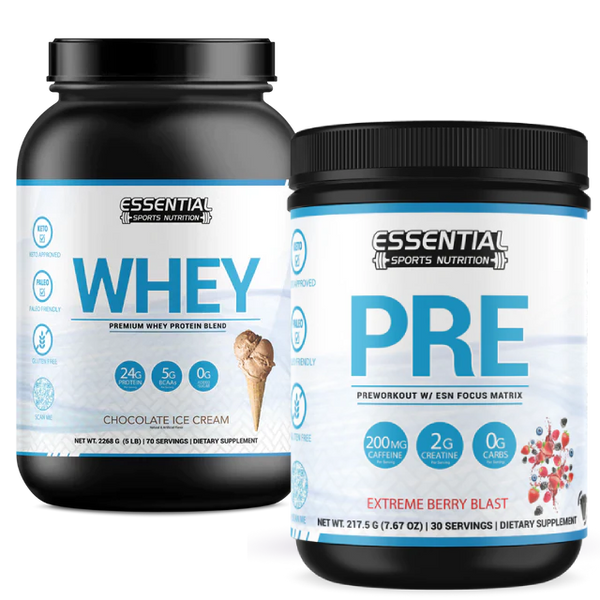Blast Your Biceps: Power-Packed Exercises for Building Monumental Muscle
To build those bicep muscles effectively, you'll want to engage both the long and short head of the bicep brachii. Start with barbell curls for mass, and then focus on peak with concentration curls. Don't overlook incline dumbbell curls, which target the lower part of the biceps brilliantly. For a resistance twist, add bands into your routine with resistance band preacher curls, boosting strength and stamina. Mixing these up guarantees balanced growth and prevents plateaus. Ensure you're giving your muscles the right challenge and recovery they need. There's plenty more you can explore to keep those gains coming.

Key Takeaways
Barbell curls are great for building mass in the biceps.
Dumbbell hammer curls target both the bicep and forearm muscles.
Preacher curls help achieve better isolation by stabilizing the arm.
Concentration curls focus on peak contraction, enhancing bicep definition.
Chin-ups and pull-ups also strengthen biceps while engaging upper body muscles.
Understanding Bicep Anatomy
To effectively sculpt your biceps, it's imperative to understand that the bicep brachii muscle, consisting of both a long and a short head, plays a pivotal role in defining the peak and overall shape of your arm. When you're aiming to enhance your arms, knowing how each head contributes to bicep anatomy isn't just beneficial—it's vital.
The long head of your biceps helps with the peak and gives your arm that impressive height when flexed. Conversely, the short head adds to the overall thickness and fullness, making your arms appear more robust. Each head responds best to specific exercises designed to target its unique function.
You can't just curl any weight and expect balanced results. Incorporating a variety of curls, like the concentrated curl or hammer curl, specifically targets the short head and complements the long head's development. These exercises are foundational in achieving well-rounded, powerful biceps.
Understanding the distinct roles of the short and long heads helps you tailor your workout to be as effective as possible. Remember, it's not just lifting; it's about crafting the muscle. So, embrace the weight, master the curl, and watch as your arms transform.
Importance of Bicep Workouts

Understanding the anatomy of your biceps sets the stage for recognizing why regular bicep workouts are so important for building strength and enhancing your arm's appearance. Bicep workouts aren't just about looking good; they're about feeling powerful and capable. Every time you engage in these exercises, you're contributing to muscle growth and greater arm functionality, which is essential whether you're lifting a heavy box or swinging a tennis racket.
Focusing on your biceps improves grip strength, an essential aspect that aids in various daily activities and sports. Strengthening the muscles and tendons around your elbows and shoulders is important in injury prevention. By strengthening these muscles, you're less likely to suffer from strain or injury during other physical activities.
The aesthetics achieved through consistent bicep workouts can boost your confidence significantly. As your arms gain definition and strength, your entire upper body benefits, enhancing your posture and how your clothes fit. This isn't just about building a body you're proud of—it's about creating a level of physical fitness that elevates your overall quality of life. So, keep up with your bicep workouts, which are key to a stronger, more confident you.
Top Bicep Exercises Overview
Let's explore the top bicep exercises that'll sculpt your arms and greatly boost your strength. The variety of movements available guarantees you can keep your workouts fresh and challenging, hitting your biceps from every angle to foster all-encompassing growth and impressive power. Here's a carefully selected list of exercises that are surefire ways to build those bicep peaks:
Barbell Curls: Stand tall and grip a barbell with hands shoulder-width apart. Lift the barbell by curling your arms upward, focusing on squeezing your biceps at the top. This foundational exercise is a powerhouse for mass building.
Concentration Curls: Sit on a bench with a dumbbell in one hand, elbow on your inner thigh. Curl the dumbbell up towards your shoulder, isolating the bicep, then slowly lower it back down. This exercise is perfect for hitting those hard-to-reach muscle fibers for sharp definition.
Incline Dumbbell Curls: Lie back on an incline bench with a dumbbell in each hand. Without swinging, curl the weights while keeping your elbows steady, then slowly return. This targets the lower part of the biceps, enhancing the overall shape.
Resistance Band Preacher Curls: Secure a resistance band under your feet, sit on a preacher bench, and curl. The consistent tension of the band intensifies the exercise, promoting strength and endurance.
Incorporate these arm workouts into your routine to see a real difference in your biceps' strength and appearance.
Effective Long Head Exercises

Focusing on the vital head of your biceps can greatly enhance the overall size and definition of your arms, so here are some exercises specifically designed to target this pivotal muscle area. Each exercise is crafted to maximize the engagement of the vital head, ensuring you get the most out of every curl and contraction.
| Exercise | Benefit | Key Technique |
|---|---|---|
| Incline Dumbbell Curls | Maximizes shoulder extension | Keep elbows back and stationary |
| Concentration Curls | Promotes isolated contraction and growth | Focus on peak contraction at the top |
| Drag Curls | Emphasizes vital head by positioning | Elbows stay behind the body |
| No Money Curl | Isolates vital head with rotation | Perform with external shoulder rotation |
| Alternating Dumbbell Curls | Balances development of each arm | Alternate focus on each bicep |
Embrace these bicep exercises to challenge the vital head of the biceps and sculpt a more defined, muscular appearance. You're setting yourself up for success through the strategic positioning in Incline Dumbbell curls and the intense focus required in Concentration curls. Remember, it's not just about lifting weights; it's about lifting them right to target those important muscle fibers effectively. So, let's get those biceps peaked and powerful!
Targeting the Short-Head
To effectively sculpt your biceps, targeting the short head is vital, which is paramount for achieving that full, rounded arm development. The short head of your bicep isn't just another muscle; it's the cornerstone of bicep aesthetics, contributing to that sought-after balanced development. Focusing on the short head can make all the difference when aiming to enhance your arms' visual impact. Here's how you can engage and isolate this pivotal muscle group:
Wide Grip EZ Bar Curls: Set your hands on the bar wider than shoulder-width to emphasize the short head bicep. As you curl, keep your elbows steady to maximize tension on the short head, building a solid foundation for your bicep aesthetics.
Concentration Curls: Sit down and lean forward slightly, holding a dumbbell with a supinated grip. Curl the weight while keeping your upper arm parallel to the floor; this position helps isolate the short head, promoting intense muscle engagement.
High Cable Bicep Curls: Attach a handle to a high pulley and pull using a supinated grip. Curl the handle towards your head, maintaining your elbow's position to target the short head effectively.
Consistent Focus: Dedicate a segment of your workout routine specifically to these exercises. Consistent effort leads to noticeable results, enhancing both the form and function of your biceps.
Best Dumbbell Movements

Dumbbell movements are vital for sculpting your biceps, offering a variety of exercises that target every muscle fiber for balanced growth and enhanced definition. When you're looking to expand your dumbbell biceps workout, incorporating a mix of movements can significantly improve your results.
Start with hammer curls to engage more than just the long and short heads of your biceps. This potent exercise also hits the brachialis muscle, which is important for arm thickness and overall strength. The neutral grip reduces wrist strain, allowing you to focus more on muscle engagement.
Next, turn to concentration curls. This exercise is a game-changer for peak contraction and muscle definition. Seated, with your elbow against your inner thigh, you isolate the bicep completely, minimizing momentum and maximizing tension at the top of the curl. It's perfect for chiseling out that bicep peak.
Don't overlook the benefits of incline dumbbell curls. Lying back on an incline bench, you can stretch your arms below your body, working your biceps through a fuller range of motion. This promotes muscle growth and ensures that every fiber in the biceps is activated.
Alternating dumbbell curls are your go-to for enhancing coordination and adding a dynamic challenge to your routine. Working each arm independently ensures balanced strength and size in both biceps.
Maximizing Workout Intensity

Optimizing load progression is essential to ramp up your bicep workouts; consistently increasing the weight you lift guarantees continuous muscle growth and strength gains. Consider integrating interval training techniques, which alternate between high-intensity bursts and low-intensity recovery, to maximize your muscle's power and endurance. Enhancing recovery periods between sets can help you maintain peak performance throughout your session, allowing for a more intense and effective workout.
Optimize Load Progression
Optimizing load progression is crucial for ramping up your workout intensity and achieving significant muscle growth in your biceps. By strategically increasing the weight in your bicep exercises, you challenge your muscles, promoting strength gains and avoiding plateaus. Proper load progression guarantees continuous muscle development, keeping your gains consistent and rewarding.
Here's how you can optimize your load progression:
Start Small: Begin with a manageable weight that allows you to maintain proper form.
Track Progress: Regularly record the weights you lift to monitor your advancement.
Increase Gradually: Incrementally raise the resistance to continuously challenge your muscles.
Listen to Your Body: Adjust the load based on your muscle adaptation and overall performance to maximize effectiveness and prevent injuries.
Interval Training Techniques
Interval training, by alternating intense bursts of bicep exercises with shorter rest periods, can dramatically boost your workout's effectiveness and efficiency. You're not just working on your arms by incorporating high-intensity exercise like bicep curl variations into your routine. You're enhancing your cardiovascular fitness, pushing your endurance, and achieving rapid strength gains. These intense intervals maximize muscle stimulation and keep the workout pace exhilarating.
Think of your interval training as cycles of explosive energy followed by vital moments of muscle recovery. This structure guarantees you're constantly challenging your muscles, yet giving them just enough rest to spring back stronger. Adapt this method in your bicep workouts to significantly improve overall performance and workout intensity.
Enhance Recovery Periods
Enhancing your recovery periods is crucial to maintaining high-intensity workouts and achieving peak muscle growth. To guarantee the effectiveness of your bicep workout, consider the following steps:
Optimize Rest Intervals: Alternate between short rest intervals of 30-90 seconds for muscle recovery and longer intervals of 2-3 minutes for maximum strength gains.
Stay Hydrated: Proper hydration supports muscle performance and aids in faster recovery.
Focus on Nutrition: Fuel up with the right nutrients to facilitate muscle repair and growth.
Balance Your Training: Prevent overtraining by carefully balancing work and rest intervals to maintain workout intensity.
Bicep Training Frequency

When crafting your bicep training schedule, hitting the sweet spot with 1-2 sessions per week is key. You'll need to give your muscles enough downtime to recover and grow, underscoring the importance of not skimping on rest days. Balancing the intensity and volume of your workouts will prevent injuries and ensure you're maximizing each session for the best gains.
Optimal Weekly Sessions
To optimize your bicep growth, it's best to limit your training to 1-2 sessions per week, ensuring sufficient recovery time to fuel muscle development. This ideal frequency helps prevent overtraining, supports muscle recovery, and contributes greatly to your growth and strength. Here's why striking the right balance is important:
Prevent Overtraining: Too much can be harmful. Give your muscles the rest they need to grow stronger.
Maximize Growth: Regular, but not excessive, sessions ensure continuous muscle gains.
Sustain Consistency: Establishing a routine builds long-term habits and results.
Tailor Intensity: With fewer sessions, you can focus on increasing intensity levels responsibly without compromising recovery.
Embrace these practices, and you'll see your biceps not just meet but exceed your expectations!
Recovery Time Importance
Understanding the importance of recovery time between your bicep workouts will guarantee you're giving your muscles the chance to repair and grow effectively. Overtraining your biceps by not allowing adequate rest can severely hinder muscle development, making those gym hours less fruitful. It's essential to strike the right balance in your training frequency—typically 1-2 times per week is ideal. This schedule ensures each session contributes positively without causing fatigue or overuse injuries. Remember, rest days are your allies; they're necessary for peak recovery. Listen to your body's signals of soreness and tiredness to fine-tune the recovery period needed. This approach will keep your bicep workouts effective and your muscle repair on track.
Intensity and Volume Balance
Striking the right balance between intensity and volume in your bicep training is essential for maximizing muscle growth while avoiding overtraining. Here's how you can fine-tune your approach to optimize your gains:
Tailor Frequency: Hit your biceps 1-2 times per week, adjusting based on how your body responds.
Monitor Indicators: Keep an eye on strength levels, muscle soreness, and fatigue to gauge if your training frequency needs tweaking.
Adjust Intensity and Volume: Increase or decrease the load and reps based on your recovery and individual goals.
Listen to Your Body: Scale back if you experience persistent soreness or fatigue, to prevent overtraining and support bicep development.
Empower your training decisions with these insights to foster impressive bicep growth and strength!
Advanced Bicep Techniques
If you want to push your bicep growth further, mastering advanced techniques like cheat-free wall curls and kneeling single-arm curls can greatly enhance muscle activation and development. These moves force your biceps to work harder by eliminating momentum, ensuring that every fiber is engaged.
Incorporating resistance band preacher curls into your routine targets the biceps from unique angles, optimizing muscle growth and increasing strength. Spider curls, another dynamic variation, isolate the biceps, intensifying the burn and maximizing hypertrophy. Both exercises are perfect for those who wish to sculpt their arms precisely.
To diversify your regimen, try band curls and suspension trainer biceps curls. These methods introduce a different type of resistance, challenging your muscles in ways traditional weights can't. This variety is essential for overcoming plateaus and continuing your growth trajectory.
Don't forget about hammer curls and cheat curls. Hammer curls help develop the brachialis, a muscle that can make your biceps appear thicker. Cheat curls, when performed correctly, allow you to lift heavier weights, which is beneficial for advanced muscle development. Always focus on form to prevent injury and ensure the most effective workout. Embrace these advanced techniques to see significant improvements in your bicep size and strength.
Conclusion

Now that you're armed with the best bicep-building strategies remember, "Rome wasn't built in a day." Consistency is key in sculpting those peaks. Incorporate these exercises into your routine, adjust the intensity, and vary the frequency to keep your muscles guessing. You'll see remarkable growth by pushing your limits with advanced techniques. Get ready to flex those impressive biceps you've worked so diligently to build. Let's make every workout count!
Best Bicep Exercises for Men FAQs
Q: What are the best biceps exercises for men?
A: Some of the best bicep workouts for men are standing barbell curls, which target both bicep heads thoroughly. Also, incline dumbbell curls, bicep curls, and dumbbell bicep exercises.
Q: How can I build bigger biceps?
A: To build bigger biceps, focus on exercises that target the biceps muscle specifically, such as bicep curls and chin-ups, and progressively increase the weight and intensity of your workouts.
Q: What is the importance of training your biceps?
A: Biceps training is essential for overall arm strength, aesthetics, and functionality, as strong biceps play a crucial role in various daily activities and upper body movements.
Q: What are some tips to get the most out of biceps workouts?
A: Ensure proper form and technique, focus on the mind-muscle connection, vary your grip and hand positions, incorporate both compound and isolation exercises, and allow adequate rest for optimal biceps growth.
Q: Can I train my biceps with just bodyweight exercises?
A: While bodyweight exercises can be effective for beginners or as part of a conditioning routine, adding resistance with weights is generally more efficient for targeting and stimulating biceps muscle growth.
Q: How often should I train biceps?
A: Depending on your fitness level and recovery capacity, aim to train your biceps 1-3 times per week, allowing at least 48 hours of rest between each session to promote muscle repair and growth.
Q: What are some common mistakes to avoid when training your biceps?
A: Common mistakes when training biceps include using momentum to lift weights, neglecting proper range of motion, lifting too heavy with poor form, and not allowing for adequate rest and recovery between workouts.
Q: Is 3 Bicep Exercises Enough?
A: Three bicep exercises are compact yet impactful, like a power trio in music. Focus on quality, mix exercises, and rotate them to avoid plateaus and maximize growth with each session.




























